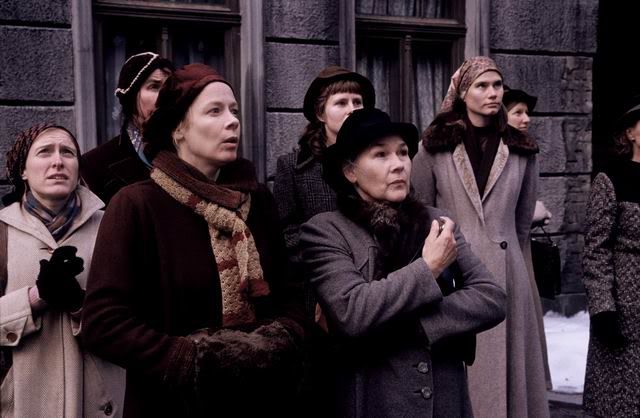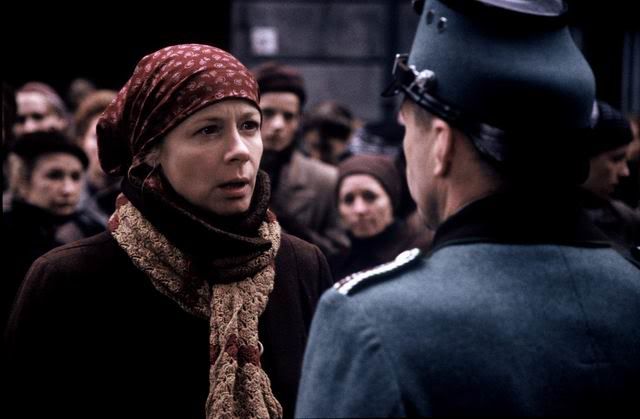Rosenstrasse tells a little known story of the 1943 protest of thousands of non-Jewish German women who had resisted the Nazi pressures on them to divorce their Jewish husbands, demonstrated when their husbands were finally rounded up, and, most importantly, succeeded in securing their release.



Moreover, the power elite who control the media do not want us to know how to resist them. An intuition that the audience might take away from films like Rosenstrasse knowledge of how to fight the power, convinced that a good fight may very well result in a practical victory, rather than just a moral triumph, is what motivates them to obstruct their production -- it took von Trotta eight years to make this film -- or dismiss the significance of their subjects if they get produced and distributed at all. Soon after Rosenstrasse was released in Germany, Wolfgang Benz, director of the Center for Research on Anti-Semitism in Berlin, tried to discount the importance of women's protest at Rosenstrasse: "Ein Teil der deutschen Juden war in 'Mischehe' mit Nichtjuden verheiratet. Diese Gruppe war in der Rosenstraße, mitten in Berlin, interniert. Die Frauen sammelten sich auf der Straße vor dem Gebäude, harrten tagelang aus, kämpften um die Freilassung ihrer Angehörigen, wurden laut und ließen sich nicht vertreiben. Sie konnten nicht wissen, dass den Männern in der Rosenstraße nicht das Vernichtungslager zugedacht war, dass sie vielmehr zum Austausch mit anderen für bestimmte Funktionen festgehalten wurden" (Wolfgang Benz, "Kitsch, Klamotte, Klitterei: Die Legende von der 'Rosenstraße,'" Süddeutsche Zeitung, September 18, 2003). In short, he questioned whether it was the Rosenstrasse women's protest that secured their husbands' release:
Benz cited an article written by his former student Wolf Gruner that postulates that the Nazis never intended to deport the people being held in Rosenstrasse 2-4. On the phone from Berlin, Gruner explains his sources. "One of them is a regional decree from Frankfurt am Oder with orders from the Reich Main Security Office for the next deportation wave," he says. "This decree specifically excluded Jews in mixed marriages from the Final Roundup."Von Trotta and Nathan Stoltzfus -- a historian who authored the most important work on the Rosenstrasse protest Resistance of the Heart: Intermarriage and the Rosenstrasse Protest in Nazi Germany (W. W. Norton, 1996) -- disagree:
. . . So if these Jews were not to be deported, why were they detained? By comparing lists of the Jewish employees who worked in Jewish organisations in Berlin both before and after the Final Roundup, Gruner concludes that the people held in Rosenstrasse 2-4 went on later to fill the jobs of Jews who had been deported. (Winters, August 13, 2004)
Von Trotta disagrees. "There were children held in that building," she says. "If the Nazis meant solely to be filling the jobs of bureaucrats, why did they hold young people there?"The controversy is but one instance of ceaseless struggles over popular memory of resistance.
Stoltzfus, who wrote a sharp riposte to Benz, concurs with von Trotta. "Deportation decrees were often used to deceive. For instance, they had been deporting Jews from Germany to Auschwitz since the middle of the summer in 1942, but no deportation directives said they were to go there until February of 1943." (Winters, August 13, 2004)
Finally, if resistance is publicly commemorated at all, those who are honored are more often men than women. Von Trotta's very choice of the subject goes against the grain. From Stoltzfus's research, we learn that:
In the decades leading up to the Third Reich, Jewish assimilation in Germany had taken the form of intermarriage. In 1904, 9.3 percent of Jewish men who married, and 7.7 percent of Jewish women, married outside the Jewish faith. Between 1910 and 1913, these averages increased, respectively, to 13.5 percent and 10.92 percent, while the war years, 1914 to 1918, saw further sharp increases to 29.86 percent and 21 percent.[49] In 1933, against the grain of the new politics, this trend was still strong, as 44 percent of the German Jews who married chose non-Jews. In 1934, with the tide of Nazi propaganda and persecution rising, this number fell to 15 percent,[50] and in September 1935 the Nuremberg Laws prohibited further intermarriages altogether, and nullified all marriage engagements between mixed couples. As of June 1935 some 500,000 persons stood on the membership lists of Jewish communities in Germany; approximately 35,000 of these lived in intermarriages.[51] . . .Therefore, the memory of the Rosenstrasse protest is doubly subversive: it not only encourages us to believe that resistance is possible but may also lead many women to remember that we have even more stakes in fighting the rise of the right than men do.
Thus after Hitler took power, fewer German men married Jews, while it was still possible, and more German men than women divorced their Jewish spouses under the Third Reich.[54] Because the large majority of intermarried Germans were women, and because these women were part of "Jewish households" -- married to men subject to every measure of the anti-Jewish persecution -- the story of opposition by intermarried Germans is largely (but not only) the story of German women married to Jewish men. (Resistance of the Heart: Intermarriage and the Rosenstrasse Protest in Nazi Germany, W. W. Norton, 1996)




No comments:
Post a Comment